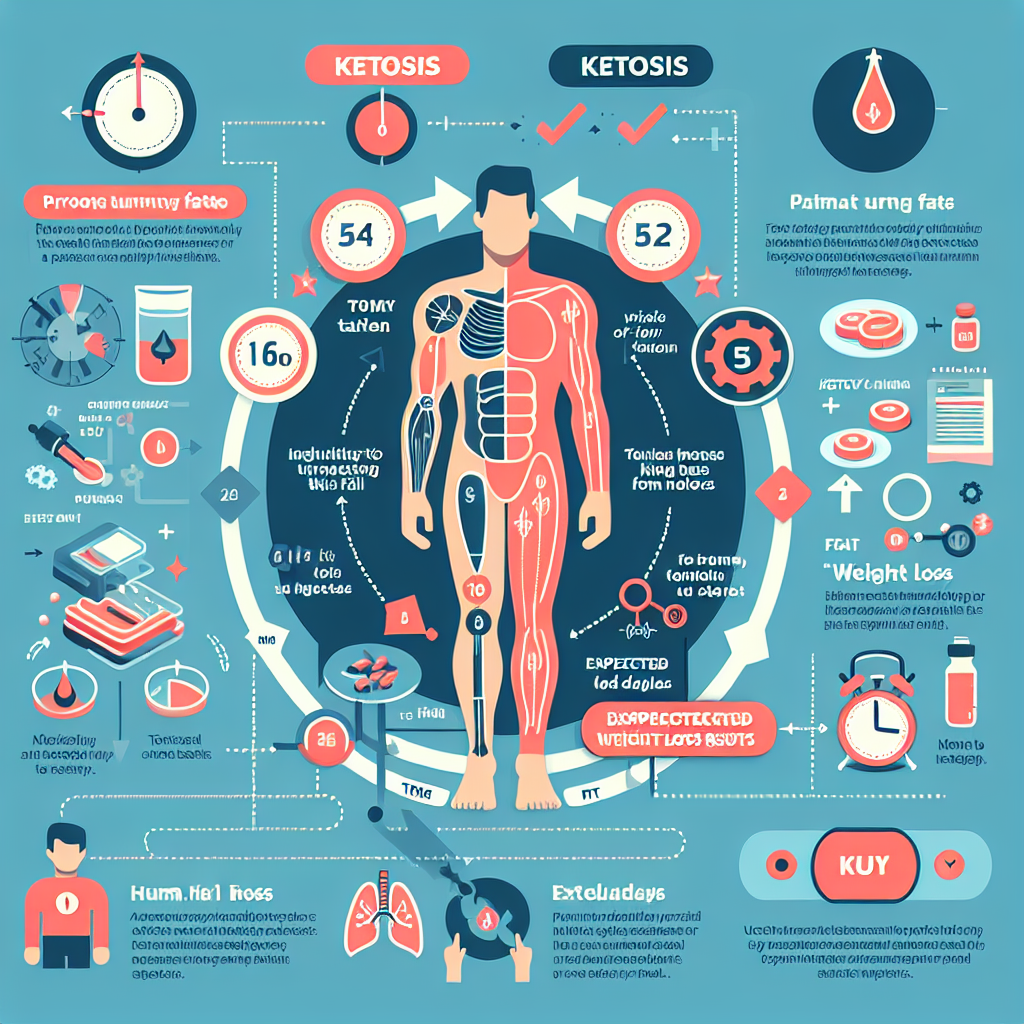Exploring How Many Days in Ketosis are Required Before Weight Loss
Ever wondered how long it takes to start losing weight once your body is in ketosis? You could be thinking about a fast weight loss plan or trying to understand the mechanisms of a ketogenic diet. It’s fascinating to learn that the process of weight loss is not a simple stopwatch that starts ticking as soon as you reach ketosis. Your body and metabolism have an intriguing way of functioning, and this article discusses just that – detailing the time frame of ketosis for weight loss and how it works uniquely for everyone. It’s more in-depth than you would imagine, but fascinating nonetheless.

Understanding Ketosis
What is Ketosis?
Ketosis is a metabolic state that your body enters when it starts burning fat for energy instead of carbohydrates. This happens when there’s a shortage of glucose (which comes from carbohydrates), prompting the liver to convert existing fat into ketones. Ketones then become the primary source of energy.
How does the body get into Ketosis?
The body goes into ketosis when it doesn’t have enough carbohydrates to fuel your cells. This lack of carbohydrates leads to a decrease in blood sugar levels which in turn prompts the release of insulin. As insulin levels drop, the body begins to break down stored fats for energy, resulting in the formation of ketones.
Ketosis vs. Ketoacidosis: Knowing the difference
Ketosis and ketoacidosis are two different metabolic states and it’s crucial to understand the difference between the two. ketosis as mentioned above, is a normal metabolic process. Ketoacidosis, on the other hand, is a serious condition that happens when the body accumulates too many ketones, causing the blood to become acidic. It’s most common in individuals with type 1 diabetes and can be life-threatening if not treated promptly.
The Ketogenic Diet and Weight Loss
Intensity of the Ketogenic Diet
The ketogenic diet is an intense form of low-carb, high-fat diet designed to force the body into ketosis. It drastically reduces carbohydrate intake and replaces it with fats to help your body burn more fats for energy. It requires strict adherence and consistency which makes it intense and challenging for some individuals.
Types of Ketogenic Diets
There are several types of ketogenic diets, and each is tailored to different lifestyles and health goals. The Standard Ketogenic Diet is the most common, with a macronutrient ratio of 70% fats, 20% protein, and 10% carbs. The Cyclical Ketogenic Diet involves periods of higher-carb refeeds, like five ketogenic days followed by two high-carb days. The Targeted Ketogenic Diet allows you to add carbs around workouts, and the High-protein Ketogenic Diet is similar to the standard one but includes more protein.
The role of the Ketogenic Diet in weight loss
A well-formulated ketogenic diet has strong weight loss implications due to its ability to induce ketosis. When your body is in ketosis, it’s burning stored fat for energy, which leads to weight loss. Coupled with the appetite-suppressing effect of consuming high fats, individuals often see significant weight loss results from this diet.

Process of Ketosis for Weight Loss
Breaking down Fat for Energy
When the body enters ketosis, it begins to break down stored fat into molecules called ketones. This switch in the body’s primary fuel source from carbs to fats can lead to weight loss as it taps into fat reserves for energy needs.
The Role of Insulin in Ketosis
Insulin is a hormone that plays a crucial role in getting us into and out of ketosis. When carbohydrate intake is high, insulin levels are elevated which prevent fat burning and promote its storage. But when carb intake is low, insulin levels decrease, encouraging the body to enter ketosis.
Benefits of Burning Fat for Energy
Burning fat for energy can heighten physical energy and stabilize blood sugar levels, reducing spikes and crashes in energy throughout the day. Moreover, once the body becomes adapted to burning fat, it can easily access the energy stored in fat cells, leading to weight loss.
Calculating the Number of Days in Ketosis required for Weight Loss
Factors influencing the Timeframe
The timeframe to reach ketosis varies for each individual, depending on factors such as carb intake, activity levels, proportion of body fat, and metabolic rate. Generally, it can take two to four days of consuming fewer than 20 to 50 grams of carbs per day.
Calculating Weight Loss Goals
Your weight loss goals should be calculated based on your desired body weight, current physical condition and the personal rate at which your body enters ketosis.
Individual differences in Ketosis and Weight Loss
We all have unique bodies, and therefore, we respond differently to ketosis. Some people may lose weight swiftly, while others may take a longer time. It’s important to remember that ongoing lifestyle changes often have more lasting impact on weight management than quick fixes.

Effects of Ketosis on the Body
Physical Changes during Ketosis
The body undergoes substantial physical changes when in ketosis. These may include rapid weight loss, reduced fat mass, elevated energy levels, and improved blood sugar control.
Cognitive and Emotional Changes during Ketosis
Many people on a ketogenic diet report enhanced mental clarity and focus. Additionally, the diet might have mood-stabilizing effects, with some research suggesting that ketogenic diets could be used as a mood stabilizer in bipolar illness.
Possible Health Risks and Side Effects
While ketosis is generally safe for most people, it can have side effects, especially in the early stages, often referred to as the keto flu. These might include headache, fatigue, nausea, dizziness, and irritability. It’s always best to consult with a healthcare provider before beginning any new diet regimen.
Strategies to Accelerate Ketosis
Intermittent Fasting and Ketosis
Intermittent fasting can help the body get into ketosis quicker. By choosing to eat within a specific timeframe and fasting for the rest of the day, the body depletes its glucose stores easier which supports the induction of ketosis.
Exercise’s Role in Achieving Ketosis
Physical activity helps deplete the body of its glycogen stores, which in turn can speed up the process of getting into ketosis.
The Role of High-Fat and Low-Carb Foods
Consuming meals that are rich in healthy fats and low in carbs can help you reach ketosis faster. These include foods like avocados, meat, eggs, and healthy oils like coconut oil.

How to Measure Ketosis
Methods for Ketone Testing
There are several ways to test for ketosis, including urine strips, breath analyzers, and blood ketone meters. Each has its pros and cons, with a blood ketone meter being the most accurate but also the most expensive.
Signs and symptoms of Ketosis
There are certain signs that can indicate that your body is in ketosis. These include weight loss, increased ketones in the blood, urine, or breath, appetite suppression, increased focus and energy, and short-term fatigue and mood changes.
Importance of Monitoring Ketosis Levels
Keeping track of whether or not you’re in ketosis is vital to ensuring that the ketogenic diet is working for your body. It helps you adjust and fine-tune your diet, and can assist in making sure you’re hitting your weight loss goals.
Maintaining Weight Loss post-Ketosis
Sustainability of the Ketogenic Diet
The ketogenic diet is not just a quick fix, but a lifestyle change. As such, it’s essential to figure out sustainable eating and exercise habits that can support your weight loss in the long term.
Transitioning out of Ketosis
Successfully transitioning out of ketosis involves gradually reintroducing carbohydrates into your meals and monitoring your body’s response to ensure you don’t regain the weight you’ve lost.
Long-term Weight Management Strategies
Long-term weight management requires consistent effort and a balanced approach to eating and exercising. Staying active and consuming a diet with plenty of fruits, vegetables, lean proteins, and whole grains can help maintain your weight loss even after you transition out of ketosis.
Common Misconceptions about Ketosis and Weight Loss
Ketosis equals Quick Weight Loss
While ketosis often results in initial rapid weight loss, libeling it as a quick weight-loss solution can be misleading. The first drop in weight is mostly water weight, and true fat loss requires sustained effort and lifestyle changes.
Ketogenic Diet equals Starvation
The ketogenic diet is not a starvation diet. Though it involves cutting down on carbohydrates, it emphasizes eating a variety of nutritious, filling foods, particularly those high in healthy fats and protein.
Predictability of Weight Loss during Ketosis
Weight loss during ketosis is not easily predictable, as it depends on several individual factors including current body weight, metabolic health, and adherence to the diet.
Conclusion: Ketosis and Weight Loss
Validity of the Ketogenic Diet for Weight Loss
Research supports the efficacy of the ketogenic diet for weight loss, primarily through its role in inducing ketosis. However, it’s not a one-size-fits-all solution, and individual experiences vary.
Personal Experiences with Ketosis
Personal experiences with ketosis are diverse. Some people have found great success with the ketogenic diet, while others find the restrictive nature of the diet challenging to maintain.
Future Research on Ketosis and Weight Loss
While current research supports the benefits of ketosis for weight loss, further studies are required to completely understand the long-term effects of this metabolic state and its impact on human health.

